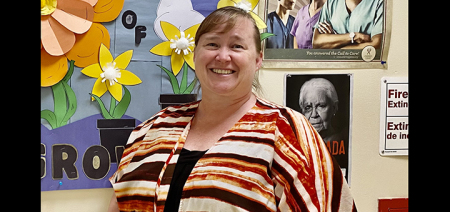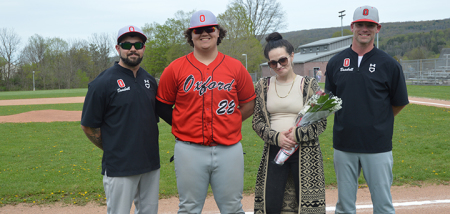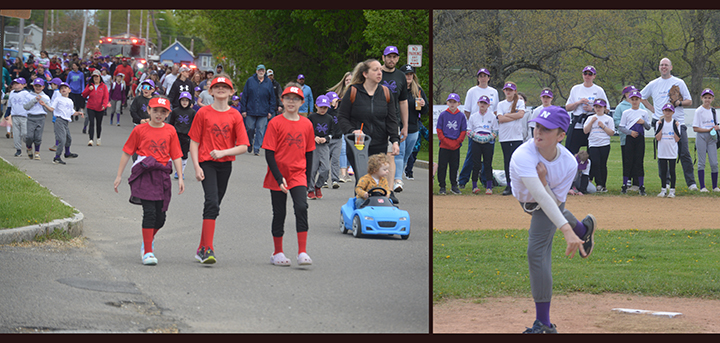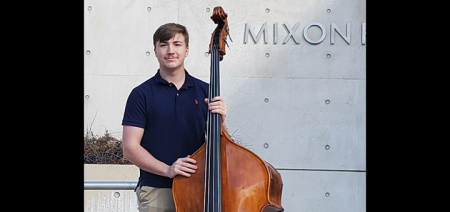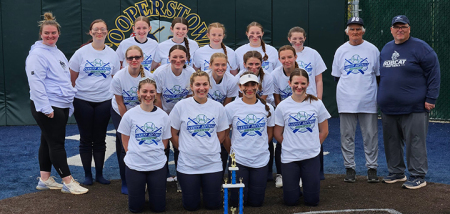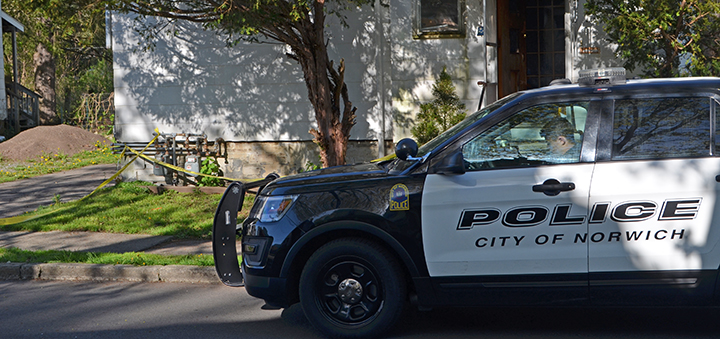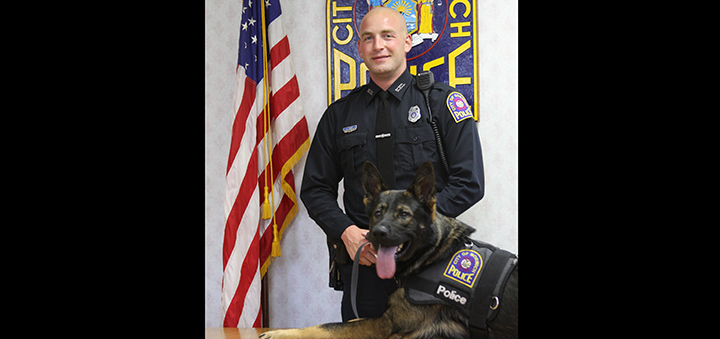NHS Sports Hall Of Fame: Jon Cook, Class Of 1962
Published:
April 1st, 2022
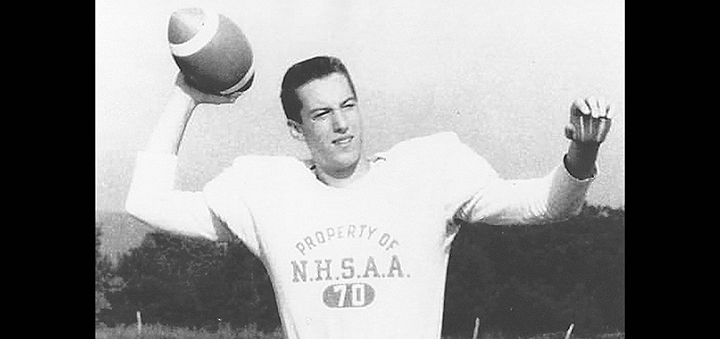 Editor's note: Today's article on Jon Cook is the third in a series profiling the Norwich High School Sports Hall of Fame 2020 and 2021 inductees. A combined ceremony for each induction class is scheduled Saturday, May 14 at the Norwich High School Gymnasium at approximately 6:45 PM. A social hour begins at 4:30 p.m. with a buffet dinner at 5:30 p.m. Tickets are $20 per person for the social hour and buffet dinner, and are available for purchase at the Norwich YMCA or the Norwich High School athletics department. There is no charge to attend just the induction ceremony.
Editor's note: Today's article on Jon Cook is the third in a series profiling the Norwich High School Sports Hall of Fame 2020 and 2021 inductees. A combined ceremony for each induction class is scheduled Saturday, May 14 at the Norwich High School Gymnasium at approximately 6:45 PM. A social hour begins at 4:30 p.m. with a buffet dinner at 5:30 p.m. Tickets are $20 per person for the social hour and buffet dinner, and are available for purchase at the Norwich YMCA or the Norwich High School athletics department. There is no charge to attend just the induction ceremony.
By Tom Rowe
Sun Sports Contributor
The term “sophomore jinx” has been bantered around for decades to describe the unexplainable fall from grace that the athlete enjoyed during his/her rookie, or should we say, freshman season. Many explanations have been given to describe the hex; like too big an ego, the opposition found an inherent weakness in the individual, the initial season was just a flash in the pan, etc.
In Jon Cook’s case, though, he didn’t just suffer a jinx during his 10th grade athletic season, he experienced a major catastrophe. As just a freshman, Cook lettered in all three sports of his choice – football, basketball and baseball – but following the 1959 grid campaign, the seemingly invincible 6-foot-3; 185-pounder, as all teenagers believe they are, was struck down with a serious kidney infection. Not only did he miss the preponderance of the basketball season – all but three games – and the entire spring of baseball, but was hospitalized for a week and home from school for another six weeks.
“I really wasn’t feeling normal for about six months,” recalled Cook. “I was going to skip football the next fall, too, but Coach (Joe) Grzibowski and Dr. (George) Manley talked me out of it.”
But, despite this unfortunate setback, Cook rebounded with aplomb, lettering twice each in all three sports during his junior and senior seasons. In fact, had he not suffered that aforementioned illness, he would have run the table with four letters in each of his three sports of choice for an even dozen – a feat unmatched by few, if any, in the annals of NHS athletics. And, because of that troika of successes, Jon Cook has earned his place as one of the newest members of the ninth annual Norwich High School Sports Hall of Fame class.
Pete Smith, who played basketball and baseball with Jon, remembers him well. “Jon was the consummate player. He was big and strong, rangy in build, in great shape, a fierce competitor, really smart both on and off the field and well-liked by teammates, classmates, coaches and fans. With Jon, giving 100 percent wasn’t a cliché, but the way he lived his life on and off the field. Nobody ever had to worry about his preparation for a game.”
Although, by his own admission, football was his favorite endeavor, his achievements on the basketball court outshone his other two sports. Even after playing in just three games as a sophomore, Cook finished his Tornado cage career with 738 points, which stands 11th best all-time. At the time of his graduation in 1962, only Harold “Clone” Ryan (1,292), John Stewart (853), Wayne “Lefty” Adams (816) and John Taranto (773) had scored more. But, since Ryan’s numbers were not substantiated until a few years ago, Cook would have left Norwich as its all-time leading scorer had he not missed the majority of his sophomore season.
“Jon’s storied NHS career began as a freshman starter on the varsity basketball team and carried through for four years as a superb three-sport athlete, despite missing most of his sophomore year,” recalled Smith. “He was a star from the start, and deservedly so, a real fan favorite – quarterback on the football team, high scorer in basketball and a terrific hitter and fielder in baseball.”
As a senior, the Norwich captain was instrumental in helping NHS produce its best record in six years with a 14-6 slate. He poured in 308 points (15.4 avg.), charted double digits in 15 of the Purple’s 20 outings and led the team in rebounding. He was also voted the Tornado’s Most Valuable Player and was selected to the All-Iroquois League team. And, as a junior, he charted his two most prolific scoring outbursts when he rang up 30 points on two separate occasions, the latter coming in a 57-46 Section 3 Class A quarterfinal triumph over Canastota at Colgate University on March 7, 1961.
“We won a whole bunch of games my senior year by one point, so the sports writers started calling us ‘cardiac kids’,” noted Cook. “And, we had a new coach in John Lotz, who became very instrumental in my life.”
Norwich won five games that year by one point – three straight during a stretch in January – and one more by just two markers. Lotz, who came to Norwich from Long Island in 1960, had coached the Tornado junior varsity for one season before moving up to the varsity following the retirement of Jim Smith, who had headed the program the previous six years.
“He (Lotz) was a very good coach, and he helped me get into Le Moyne on a basketball scholarship. Without Coach Lotz, I never would’ve gone to a four-year college,” noted Cook. “During the summer of 1963 before my sophomore year in college, he invited me to volunteer at a basketball camp in Norwich, and I got to meet Dean Smith, who was early in his coaching career.”
Smith, who had just completed his second year as the head coach at the University of North Carolina, would join forces with Lotz again two years later. Following his one-year stint as the Tornado’s head honcho, Lotz returned to Long Island where he guided Massapequa for two seasons before taking over as Smith’s Tar Heel assistant in 1965. He remained there until 1973, when he was hired as the head coach at the University of Florida, a position he would hold for seven campaigns. Smith, meanwhile, went on to a legendary career at UNC, from where he retired in 1997 with an NCAA-best 879 victories.
Danny Lotz, John’s younger brother by two years, was probably the main reason the Smith-Lotz team joined forces. Danny was a sophomore forward on UNC’s 1957 NCAA championship basketball squad that finished the year undefeated at 32-0. And, he later captained the 1959 Tar Heel five when Smith was an assistant coach, so the Lotz legacy was familiar to Smith. So, in a way Danny impacted Cook’s later life, too, as he was married to renowned evangelist Billy Graham’s daughter, Anne. Both Lotz’s were major contributors to the Fellowship of Christian Athletes while in North Carolina.
“I reconnected with Coach Lotz again shortly after we relocated to North Carolina. He was working at UNC as the assistant athletic director,” explained Cook. “He again impacted my life greatly by referring many business contacts, and he invited me to his bible study group. I still attend the same bible study group weekly, and I still have clients related to him or his friends. So, the Lotz family has had an ongoing impact on me, both personally and professionally.”
Lotz had nothing to do with Norwich baseball, but Cook’s three-year resume on the diamond was just as impressive as his hardwood career. Dubbed “The Freshman Flash” in a 1959 article in The Norwich Sun, Cook was still recuperating from his kidney infection when his sophomore season dawned. But he made up for lost time during his final two springs in Purple flannels, playing a flawless third base and being named to the All-Iroquois League nine.
Following up on his impressive return to the NHS hardwoods during his junior winter, Cook showed little ill effects from missing a year at the plate as he batted a robust .405 (15-for-37) in the springtime of 1961. In addition to that hefty batting average, he scored 12 runs, drove in another 10 and collected a mound victory in relief. He wasted little time in showing that he was back with a vengeance as he led the way in the Tornado’s season opener on April 19 with a perfect 4-for-4 day at the plate, that included four RBI and two runs scored in a 7-4 victory over non-league foe Oxford.
And, although his batting average slipped a bit during his final diamond spring, his power numbers grew precipitously. Besides rapping the horsehide at a .348 clip (16-for-46), Cook took opposing pitchers deep on five occasions, produced 18 runs batted in and scored 24 times for the Purple. His best outing was a 3-for-5 performance, which included a home run and a double, in the nightcap of an April 24 twin bill versus Little Falls, when Norwich routed the Mounties 39-10, thanks to his six RBI and seven runs scored.
As is evidenced by the previous recanting of Cook’s return to action in basketball and baseball, he certainly had lost little of his former luster, despite missing most of his sophomore season. But, prior to returning to the hardwoods and the diamond, he not only had to initiate that first step back on the grid iron but as the starting quarterback, no less.
“My favorite sport was football, because it came easiest to me. When I was a freshman, I was an end, and that was the position I was best at, because I had good hands and liked to run,” recalled Cook. “In training camp prior to my sophomore year, they noticed I could throw, so I got stuck being backup quarterback (to Stan Morgenstein) and rarely played. I should have been an end. I just wanted to catch the ball and run. I was in the wrong position; otherwise football would’ve been my best sport.”
He weathered the storm, so to say, but with little fanfare as the Tornado won only one of eight outings. Things changed slightly during his senior year of 1961, when as the Purple captain he led the team in scoring with 24 points, and was chosen to the All-Iroquois League squad as a first-team punter and second-team quarterback.
As the NHS punter, he averaged 43.7 yards for his 17 boots; the longest being a prodigious launch of 67 yards during a 6-6 draw with Ilion at Alumni Field on Sept. 30 before an overflow crowd of 3,000 in the first night game in Norwich history, thanks to portable lights.
“I taught myself how to punt and practiced before, during, and especially after practice every day and during the off season,” explained Cook on how he mastered those booming boots. “I was very proud of my punting, and felt I could have punted at the college level.”
Although he never played football, Smith agreed with Cook’s assessment of his punting prowess. “This is just an opinion that cannot be confirmed or denied, but I just want to state what I think would have been Jon’s outcome in sports had he played in the 21st century. While he was certainly a superb all-around athlete, his one talent where his greatest margin of superiority was punting a football. Thus, in this age of specialization, sports camps and scouting, I think he would have wound up punting for a big-time college.”
Football, however, would take a backseat once he graduated from Norwich in 1962. The recipient of the prestigious Judge David Lee Award signifying the Most Outstanding Athlete in his senior class, Cook went on to play both basketball (three years) and baseball (two seasons) at Le Moyne College.
Following his graduation from Le Moyne in 1966, he worked at Ernst & Ernst in Syracuse and obtained his CPA. He returned to Norwich (1971-83) and started his own accounting practice – Jon K. Cook & Co. CPA – on the second floor of the Carl Payne Building (currently Preferred Mutual across from the post office). He sold the practice in 1983, and the family moved to Florida.
“That’s when I got into financial planning, investing and estate work,” noted Cook. “I got so busy working with and helping my New York clients, we moved back to Syracuse in 1986. Then in 1993, we moved to Cary, NC.”
He has been there ever since with his wife, Jane, of 55 years, and is still actively involved in the financial planning business as the founding head of the Cook Wealth Management Group in Raleigh. The group is also licensed with offices in Massachusetts and Texas. His son, Brian, is a managing partner in the firm, and lives in Northampton, MA, while his eldest child, Stephanie, resides in Spain, where she is an independent financial advisor. He and Jane are also the proud grandparents of six.
Gone are those three-sport, halcyon days of Norwich, but he still remains active athletically. “I like longer distance road biking (30-50 miles), unless it’s too hot. If it’s over 90 degrees, I ride my indoor bike. It’s more difficult, though, since there’s no coasting. The indoor bike won’t let you stop pedaling,” quipped Cook. “I also see a trainer three times a week, and play squash, pickleball and tennis once in a while.”
Norwich, however, remains close to his heart. “I enjoyed my Norwich school days. They were pretty happy times,” recalled Cook. “I practically lived at the Y. That’s where my love for all sports grew. Everyone went there for everything – dances as well as sports.”
In addition to his recall of Cook’s athleticism, Smith remembers his social side with a humorous antidote. “Jon wasn’t really what one would call a ‘Ladies Man’ or a ‘Social Butterfly’ but he did have lots of friends, both male and female. The young lady whom I remember him dating most was Vicki Gilmour, and one had to admire his taste there. She was, by this underclassman’s estimate, not only the cutest girl in the class of ’62, but also the nicest. Jon was, and still is, among the tallest gents in the class, and Vicki was one of the shortest. So, they were a real Mutt and Jeff couple.”
Besides the social scene at the Y, Cook remembers how a trio of coaches shaped his high school future. “Bob Van Tine taught me how to play basketball, George Echentile (swimming) and Charlie Myers (tennis). They were heavily involved in the local YMCA programs, and got me into sports. The Y had great programs, and without them I would’ve been a dud.”
Not surprising, all three of those aforementioned mentors are members of the Norwich Sports Hall of Fame. And, four other former NHS athletes – Pat Quinn, Ed Ackley, Charlie Townsend and Fred Swertfager – had a major influence on Cook as a young boy, too.
“They were all my idols,” said Cook. “I patterned my basketball play after Pat as he had a unique jump shot and everyone wanted to kick their feet up like him. I was only 9-years-old when Ed graduated and I looked up to him immensely. Then, he became my next-door neighbor (1970-83). Charlie and Fred were a little closer to me age wise and they taught me a lot about baseball.”
That wealth of athletic knowledge passed along by those NHS Hall of Famers obviously paid major dividends in helping define Cook’s legacy, but nothing catapulted him onward better than the antibiotic Furadantin that was the needed panacea to cure him of his kidney infection. Brought to fruition by local pioneering research scientists Drs. Henry and Mary Paul in 1953 for the Norwich Pharmacal Company, you might say that medication was not only a sound investment in his future athletic endeavors but his later life, as well.
Comments

